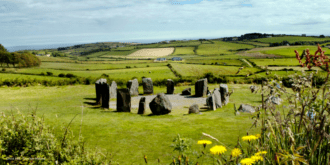Recently updated on May 7th, 2024 at 10:30 am
The man, the myths and legends of Ireland’s big day
St. Patrick’s Day is six months away… but who’s really counting? We at The Gab happen to sham-rock out for celebrating Ireland’s patron saint and of course, all things Ireland. We firmly believe it’s never the wrong time to get excited about Ireland.
But, here’s a fun fact: A lot of what we think we know about St. Patrick and his day is, well, not always on the correct road, so to Brendan-speak. Come on a journey with us as we chart a map to the facts and fictions about the man and the traditions of St. Patrick’s Day.
The Man

Ah yes, the legend himself. A towering figure of Ireland, the primary patron saint of the Emerald Isle and icon of the biggest international celebration of being (at least for the day) Irish. So who was he, really? Turns out St. Patrick – not actually Irish. British-born in the 4th century, he was kidnapped at age 16 and worked as an enslaved animal herdsman.
Upon escape and return to Britain he decided to go back to Ireland as a missionary after a dream, detailed in in one of his writings, Confessio. He’s credited for having widely spread the Christian religion to the Picts and pagan Ireland. There’s also something about snakes in there too, more on that coming up next.
You don’t have to go through the troubles of a saint to see the beauty of Ireland and Britain – we’ve got plenty of trips that take you to both.
The Myths

Corned beef and cabbage for Ireland? Never met her. Sure it’s a dish most people eat for St. Patrick’s, but mainly in non-Irish countries, mostly popularized in the United States as “traditional fare.” In Ireland herself, you’ll probably dine on dishes like shepherd’s pie, roast, or perhaps an Irish stew. Ireland’s food tours, like in Dublin or Galway give you a true taste of what’s on the menu. And of course, if you imbibe, let us remind you to not forget your Guinness or Jameson.
As for those snakes we mentioned earlier – St. Patrick’s big claim to fame is thought to have been driving all the snakes out of Ireland. Not quite what you think though – there’s never been any actual coldblooded creatures on Ireland’s craggy shores, rather, “snake” was an illustrative term referring to pagans.
The Legends

Nothing endures quite like a good story in Ireland, it is the nation of storytellers, after all. So here’s a few *gasp* shocking trivia notes about St. Patrick’s Day that have traveled from the realm of reality into the world of legend.
Green – it’s the Emerald Isle and the color of Ireland and CERTAINLY the color of St. Patrick…. Right? Not always as it turns out. His original color was blue, Ireland’s historic color of rule. Due to its association with British rule, blue became replaced by green, associated with the push for the Irish fight for independence.
What else is green in Ireland? it’s infamously gorgeous countryside – filled with the iconic shamrock. This tiny, three-leaved clover is just as lucky as its even numbered counterpart, and its symbolic meaning predates St. Patrick’s retooling as an evergreen example of the church’s trinity concept. Before him, it was a welcome symbol of the coming of spring.
While spring and St. Patrick’s Day are still a half a year away, we’re going to keep thinking about shamrocks and leprechauns (and our trips to visit them). Until the big day comes, sláinte!
St. Patrick’s Day is the biggest Irish holiday in Ireland – and around the world. Brendan Vacations has fully vaccinated travel to Ireland, Scotland and Britain, and we invite you to plan for the future and celebrate with us.

Brittany Hanson
Related Articles




Why is Giant’s Causeway one of Northern Ireland’s Top Attractions?


